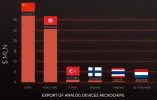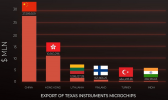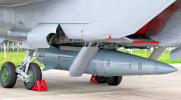Short circuit. How Europe turns a blind eye to Russia smuggling dual-use microchips
Michael Weiss
21 August 2023
In spite of sanctions, microchips from U.S. companies Texas Instruments and Analog Devices continue to be imported into Russia, where they have military applications. These violations are hiding in plain sight, in registered customs data.
Art by Mart Nigola / Delfi Estonia
With contribution from Holger Roonemaa (Delfi Estonia)
Despite export controls and sanctions imposed after Moscow’s full-scale invasion of Ukraine last year, The Insider has learned that tens of millions of dollars worth of microchips produced by two U.S. technology giants, Texas Instruments and Analog Devices, were shipped to Russia in a nine-month period in 2022. These microchips are used in Russian missiles and satellite communications integral to the Kremlin’s war effort, not to mention its ongoing attacks on Ukrainian civilian infrastructure.
Between early March and late November 2022, third-party companies supplied Russia with American-manufactured electronics from all over the world. Not only via main clearinghouses in China and Hong Kong, which don’t have sanctions in place against Russia, but also through Western companies in countries that do. They include Germany, Lithuania, the Netherlands, Estonia, and Finland, all EU and NATO allies, which have provided extensive humanitarian and military aid to Ukraine.
According to Russian customs declarations, between March 1 and November 30, 2022, $89 million worth of Analog Devices-manufactured microchips and $50 million worth of Texas Instruments-manufactured ones were imported into Russia from foreign jurisdictions. Many of those microchips have military applications, according to Leonid Dmitriev, a Ukrainian military expert The Insider consulted.
“Thirty to forty percent of the microchips have direct military analogs for encryption and decryption options or precision targeting mechanisms,” Dmitriev said. “Some of the elements uncovered from missile or drone wreckage in Ukraine have been identified according to secondary features, because they fragmented on impact. And Russians also often delete factory marks from the elements.”
Import data is readily accessible to anyone through Import Genius, a fee-for-service website that allows people to examine customs traffic in a host of countries. The data set The Insider examined represents just a small snapshot of what looks like extensive violations of U.S. and EU sanctions in the course of the 18-month conflict.
The scheme was pretty straightforward: a private company registered in a foreign country acquired the Texas Instruments or Analog Devices microchips and then resold them to a private Russian import company. The bills of lading clearly identified the nature of the wares being shipped to Russia. The imports were next logged by the Russian Federal Customs Service. From there, their final destination and end-users remain unknown.
The scheme was pretty straightforward: a foreign private company acquired TI or AD microchips and resold them to a private Russian importer
According to state contracts The Insider has reviewed, most of the Russian import companies that received the Texas Instruments or Analog Devices microchips have at some point also sold unknown electronic equipment to subsidiaries belonging to Russia’s defense and intelligence entities, including those specifically sanctioned by the U.S. and EU for the war in Ukraine. These subsidiaries include those belonging to the Federal Security Service, or FSB (Russia’s domestic security service and one of the successor agencies of the Soviet KGB); Rosatom, the company that handles Russia’s atomic energy agency; Rostec, the manufacturer of Russia’s conventional weapons arsenal including its aircraft; and Roscosmos, which is in charge of Russia’s space program. The relevant subsidiaries make radar and radio telemetry systems, drones, thermal imaging cameras, ignition systems for military aircraft engines, guidance systems for air defense platforms, laser-guided weapons, and rocket engines. One holding of Rosatom, the Institute of Automation, even manufactures nuclear weapons.
The Insider sent detailed questions to the Dallas-based Texas Instruments, one of the largest producers of microprocessors globally, and the Wilmington, Massachusetts-based Analog Devices. Neither responded.

Both companies, however, have declared their commitment to enforcing U.S. sanctions.
A statement posted on the Texas Instruments website currently reads:
“TI is not selling any products into Russia or Belarus…TI complies with applicable laws and regulations in the countries where we operate. We do not support or condone the use of our products in applications for which they weren’t designed.” Similarly, Analog Devices has affirmed, “Following Russia’s invasion of Ukraine, and in compliance with U.S. and EU sanctions, Analog Devices ceased business activities in Russia, and in the Russian-backed regions of Ukraine and Belarus, and promptly instructed all of our distributors to halt shipments of our products into these regions.”

The U.S. has banned the sale of American-made integrated circuits and equipment to Russia without a license. Restrictions also affected the re-export of microchips, including those produced using U.S. technology. According to U.S. Secretary of Commerce Gina Raimondo, shortages of these goods have forced Russia to harvest chips from dishwashers and refrigerators. Similar sanctions are also in effect in the EU.
The problem is violations are rife. They’re also hiding in plain sight.
Russian economist Maxim Mironov analyzed Russian customs data and found that in 2022, imports of semiconductors almost doubled compared to before the war. An investigation jointly conducted by Reuters and the Royal United Services Institute (RUSI), a London-based think tank, showed that between April 1 and October 31, 2022, electronics worth $2.6 billion were imported into Russia, of which $777 million were made by Western firms, Texas Instruments and Analog Devices among them.
In 2022, Russia's imports of semiconductors almost doubled compared to before the war
The RUSI report, relying on Ukrainian website InformNapalm, reconstructed a Russian reconnaissance drone relaying precise coordinates of a convoy of Ukrainian trucks and personnel. The R-168 Akveduk radio used to relay those coordinates, to a Russian artillery brigade, was built with “a microcontroller manufactured by… Analog Devices, and a digital signal processor made by Texas Instruments.”
One Russian importer, NPK Fotonika, registered in St. Petersburg, received $96,000 worth of microchips from Texas Instruments between March and November 2022 and $403,000 from Analog Devices in the same time period. NPK Fotonika had four contracts from 2014-2018 to sell, among other things, microchips, to the Central Design Bureau of Automation. This company is owned by Russia’s state-owned Tactical Missiles Corporation, and produces, among other things, homing devices for ballistic missiles.
As has already been reported, microchips made by Texas Instruments and Analog Devices have been recovered from the guts of exploded or downed Russian Kinzhal hypersonic missiles, munitions regularly fired at Ukrainian apartment blocs and other civilian infrastructure. Kinzhals have been responsible for killing or wounding untold numbers of Ukrainian civilians since the start of Russia’s invasion on February 24, 2022.
TI and AD microchips have been recovered from the guts of downed Russian missiles that killed and wounded untold numbers of Ukrainian civilians
Two divisions of the FSB have also been supplied by the Russian importers, which have purchased the American microchips. Military Unit 35533 develops electronics and software for the Russian security services and Unit 45187 engages in research and development.
Moscow-registered Russian importer Makro Tim ordered approximately $226,000 worth of microchips from Texas Instruments and $211,000 from Analog Devices from March through November 2022. The same company was a regular supplier of electronics to FSB Unit 35533 between 2011 and 2019, with at least 86 confirmed orders of microchips, other electronic devices and components.
Another Russian import company, Microsan, brought in $1,105,000 worth of Analog Devices microchips and $527,000 worth of Texas Instruments microchips, again from March to November 2022. During the last decade Microsan has entered into state contracts worth at least $5 million with a variety of Russian government agencies, among them FSB Military Units 35533 and 45187. Unit 35533 even bought microchips from Microsan, although the manufacturer is not available from the contracts The Insider has analyzed.
However, the bulk of American companies’ microchips have reached Russian importers through China or Hong Kong, which have been the two top exporters of Texas Instruments and Analog Devices’ trade brands since the invasion.
The bulk of American companies’ microchips have reached Russian importers through China or Hong Kong
For example, in May 2022, a Hong Kong company called Hongkong Chip Line International Co. Limited sold a batch of AD7450BRZ microchips manufactured by Analog Devices to a Russian import company called Kvantum, registered in Moscow. The AD7450BRZ is a one-channel 12-bit analog-to-digital converter recovered by Ukrainians from downed Kinzhals. According to Leonid Dmitriev,
“Simplifying the things maximally, the analog-to-digital converter is responsible for transforming the analog data from the sensors to the digital 'language' that the board computer understands.
For example, the sensors tell the computer the telemetry parameters (velocity, angular velocity, position, position of ailerons/flaps). The analog-to-digital modules 'translate' the telemetry parameters from the sensors (electric pulses) into the binary code and pass them further to the board computer, which compares the current values with those prescribed when programming the route, after which the board computer tells the avionics to correct the course.”

A Kinshal hypersonic missile
In November 2022, a Win Key Limited, another Hong Kong-registered company, sent 28 pieces of ADF4351BCPZ-RL7 microchips manufactured by Analog Devices to a Russian import company called Azimut, registered in Moscow. These chips are broadband frequency synthesizers that have been found in downed Russian Takhion drones in Ukraine. In total, from March through November 2022 Win Key exported $2.6M worth of Texas Instruments and Analog Devices microchips to Russia.
While Hong Kong and Beijing might be expected to look the other way on Western export restrictions, customs data also shows that some of the most pro-Ukraine countries are using companies and ports the same way.
Lithuania, a staunch supporter of Kyiv and a provider of more than $436M in weapons provisions to Ukraine, ranks third among exporting countries of Texas Instruments products into Russia, according to information The Insider has reviewed. It is followed by Finland, which joined NATO in April after popular support for the alliance surged in the wake of Russia’s invasion. Meanwhile, Turkey, another NATO ally, which, despite its close ties with Russia, has been an outsize source of security assistance to Ukraine, ranks third among exporters of Analog Devices microchips. Fourth is Finland and sixth is the Netherlands, which has sent over $1.3B in weapons to Ukraine, including Patriot air defense missile batteries, and is now leading the effort to train Ukrainian pilots to fly F-16s.
Lithuania, a staunch supporter of Kyiv, ranks third among exporting countries of Texas Instruments products into Russia
Despite being bound by sanctions regulations from the EU, Finland, Lithuania, Estonia, and the Netherlands all continued to supply Texas Instruments and Analog Devices equipment to Russia via intermediary companies from March to November 2022, consignments collectively amounting to around $3.4 million.
Take Estonia’s Elmec Trade. This company exported around $2 million worth of Texas Instruments and Analog Devices microchips from March through November 2022, a fact that has drawn intense international scrutiny. The U.S. Department of Treasury sanctioned Elmec Trade and its Russian trading partners, LLC Kvazar and LLC Spetsvoltazh, in May, specifically citing its shipment of “millions of dollars of electronics to Russia since the beginning of Russia's full-scale invasion of Ukraine.” Since then, Elmec Trade’s ownership and management have been handed over to a local Estonian lawyer, Andrus Kasela.
In an interview with The Insider, Kasela said the company is no longer in operation and will be dissolved by his law office. Kasela said his law firm acquired the parent company of Elmec Trade after the latter was added to the sanctions list. “According to information available to me it was added to the list incorrectly on mistaken grounds,” he said. “As far as we know, the company has not violated any sanctions or laws.” Nevertheless, Kasela said he is dissolving the company because of what he claims are the high legal costs of contesting the sanctions.
“Of course, the company is against the war in Ukraine, where people are dying.”
Idatrading, another Estonian company, supplied American Analog Devices microchips to Russia for $50,000, achieving record corporate revenue for 2022. Vladimir Trufanov, the sole owner and board member of Idatrading, told The Insider: “I confirm that all relations with the Russian company, according to the period of imposed sanctions, have been terminated. With the introduction of certain sanctions packages, export declarations are impossible. At the moment the company maintains trade relations – not contrary to the sanctions – with China and the Republic of Turkey. The volume of trade transactions has decreased by about 80 percent.”
Trufanov added: “Of course, the company is against the war in Ukraine, where people are dying.”
Germany’s Wwsemicon is another example. It was owned and led until 2015 by Vladimir Avetissjan. A man by the same name, The Insider has determined based on Russian court records, also controls a Russian company called Compel. Before the war, Compel was an official distributor of Texas Instruments products in Russia. From March through November 2022, customs data shows, Wwsemicon imported Texas Instruments and Analog Devices electronic components into Russia in excess of $1.6 million. Almost exclusively, its Russian partner in these transactions was Compel, a long-term reseller of electronic components to Russian state military enterprises.
Woerd-Tech (previously known as Radio-Electronic), a Dutch company, is owned by Dmitry Kudryavtsev, who was arrested in September 2022 in the Netherlands for circumventing sanctions. According to the Dutch news outlet Volkskrant, Kudryavtsev had been living in the Netherlands for decades. He purchased and imported microchips, components for drones, and barrels of cerium oxide, a substance with widespread application but which is used in electrodes, infrared filters and catalytic converters. Kudryavtsev placed orders and then repackaged the product as cargo intended for the Maldives. Their actual destination was Russia. Kudryavtsev was released on bail and fled to Russia in February. Volkskrant reported that neighbors saw him leaving his house with his family in a fully packed car.
Woerd-Tech, The Insider has found, exported Texas Instruments and Analog Devices microchips worth $1.2 million into Russia from March through November 2022. Its partners included a Russian company known as a supplier of components to a manufacturer of electronic warfare devices.
None of these European companies responded to The Insider’s request for comment on this story.
According to Dan Fried, the former State Department Coordinator for Sanctions Policy under both Barack Obama and Donald Trump’s presidencies, uncovering and blocking channels for microchip and other high-tech exports to Russia is a lengthy process. “It will take serious conversations with manufacturers and intermediate companies,” Fried told The Insider. “Know-your-customer protocols need to be extended down the chain. That’s a nice way to put it. Another way to put it is that the threat or reality of heads on a pike, metaphorically speaking, may be needed to focus the minds of some American companies.”
Читать на русском языке

 www.is.fi
www.is.fi












